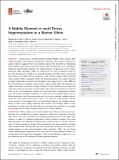A Mobile Element in mutS Drives Hypermutation in a Marine Vibrio
Author(s)
Chu, Nathaniel David; Clarke, Sean Aidan; Timberlake, Sonia Crago; Polz, Martin F; Grossman, Alan Davis; Alm, Eric J; ... Show more Show less
DownloadChu-2017-A Mobile Element in mutS Drives Hyper.pdf (1.775Mb)
PUBLISHER_CC
Publisher with Creative Commons License
Creative Commons Attribution
Terms of use
Metadata
Show full item recordAbstract
Bacteria face a trade-off between genetic fidelity, which reduces deleterious mistakes in the genome, and genetic innovation, which allows organisms to adapt. Evidence suggests that many bacteria balance this trade-off by modulating their mutation rates, but few mechanisms have been described for such modulation. Following experimental evolution and whole-genome resequencing of the marine bacterium Vibrio splendidus 12B01, we discovered one such mechanism, which allows this bacterium to switch to an elevated mutation rate. This switch is driven by the excision of a mobile element residing in mutS, which encodes a DNA mismatch repair protein. When integrated within the bacterial genome, the mobile element provides independent promoter and translation start sequences for mutS—different from the bacterium’s original mutS promoter region—which allow the bacterium to make a functional mutS gene product. Excision of this mobile element rejoins the mutS gene with host promoter and translation start sequences but leaves a 2-bp deletion in the mutS sequence, resulting in a frameshift and a hypermutator phenotype. We further identified hundreds of clinical and environmental bacteria across Betaproteobacteria and Gammaproteobacteria that possess putative mobile elements within the same amino acid motif in mutS. In a subset of these bacteria, we detected excision of the element but not a frameshift mutation; the mobile elements leave an intact mutS coding sequence after excision. Our findings reveal a novel mechanism by which one bacterium alters its mutation rate and hint at a possible evolutionary role for mobile elements within mutS in other bacteria.
Date issued
2017-02Department
Massachusetts Institute of Technology. Institute for Medical Engineering & Science; Massachusetts Institute of Technology. Department of Biological Engineering; Massachusetts Institute of Technology. Department of Biology; Massachusetts Institute of Technology. Department of Civil and Environmental Engineering; Massachusetts Institute of Technology. Center for Microbiome Informatics and TherapeuticsJournal
mBio
Publisher
American Society for Microbiology
Citation
Chu, Nathaniel D., Sean A. Clarke, Sonia Timberlake, Martin F. Polz, Alan D. Grossman, and Eric J. Alm. “A Mobile Element in mutS Drives Hypermutation in a Marine Vibrio.” Edited by Mary Ann Moran. mBio 8, no. 1 (February 7, 2017): e02045–16.
Version: Final published version
ISSN
2150-7511